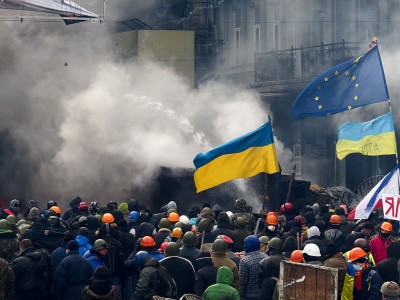In May, Ukraine, which has not experienced any internal military conflict for the last 60 years, is close to slip into a full-fledged war. The government launched a large-scale military operation against rebels that tried to separate Donetsk and Luhansk regions from Ukraine by declaring them independent republics which would join Russia as soon as possible. The conflict may last long as rebels are strongly supported by Russia whose ultimate goal is to bring Ukraine into its sphere of influence.
The rebellion in the South-East of Ukraine began in April when armed separatists seized a number of local government buildings and law enforcement departments in some towns in Donetsk and Luhansk regions (usually named as Donbas), important industrial regions with the total population of 6.6 m. In May, rebels gradually took control of those towns, established a network of checkpoints on roads, seized some Ukrainian military bases, and took control of local TV broadcasting. The government in fact lost control over about a half of the territory of Donbas and started a military operation to counteract an outbreak of hostilities in the region. Government troops blocked the spread of the rebellion and cleared a few towns of rebels. According to the Ministry of Health of Ukraine, as of June 11, the number of people killed during the conflict amounted to 270.
The conflict has characteristics of both civil war and external aggression. On the one hand, the bulk of the rebels were locals, supported by many regional officials and law enforcement officers. According to the central government estimates, about a third of local residents participated in the so-called referendum on “independence” of Donetsk and Luhansk regions from Ukraine on May 11. Donbas was a stronghold of former President Viktor Yanukovych who had fled Ukraine in February and unlike other regions of Ukraine generally did not favour the new government. The intransigency of Donbas residents stems from a lengthy and massive propaganda campaign which was organized by regional authorities and by Russia. The campaign persuaded a significant portion of locals that people from other regions of Ukraine were hostile to them and that the new government in Kyiv was a “fascist junta”.
On the other hand, the conflict had clear signs of external aggression. Gunmen from Russia were the core of the most effective rebel troops. The most influential separatist leaders were Russian citizens that had come to Ukraine recently. Rebels got weapons from suppliers located in Russia, including tanks, man-portable air-defence systems and the latest assault rifles. Besides, the Russian government supported separatists by deploying troops on the border with Ukraine and conducting a massive propaganda campaign.
The war should be considered in the context of persistent attempts by Russia to bring Ukraine into its sphere of influence. In March, Russia annexed Crimea, a peninsula with population of 2.4 m in the south of Ukraine, after it failed to divert Ukraine from the course for European integration. The escalation in Donbas could have been a first step of a large scale Russian intervention into the mainland Ukraine. However, those plans were stopped after Western countries threatened Russia with sectoral sanctions. As a result, Russia started a kind of hybrid war against Ukraine, which combined irregular warfare, civil war, and terrorism, to achieve its goals and avoid sanctions. It implies that the conflict is likely to be long lasting.
In May, the central government tried to resolve the conflict by negotiations and offered to grant more powers to local authorities and guarantee the right to use the Russian language in the region. But those attempts were unsuccessful as rebel leaders rejected any compromise with the government.
However, the intensity of fighting was rather low. Troops were constantly fighting only in the area near the adjacent towns of Slaviansk and Kramatorsk, located at the north of Donetsk regions. Occasional hostilities took place also near a few other cities and towns. Low intensity of fighting was due to several reasons. First, the military strength of rebels was very limited. Their troops numbered only a few thousand as rebels failed to involve a large number of locals in fighting. Second, rebels concentrated in towns and in fact used local residents as a human shield. It prevented government troops from entering the towns because the government strongly tried to avoid casualties among civilians. Third, the wealthiest local businessmen might influence both rebels and the central government. It may be surprising that, despite the military conflict, the largest production facilities in the region neither stopped nor significantly reduced production (with only a few exceptions). Given those reasons, it may be assumed that intensity of military operation will continue to be rather low.
Although the conflict affected mostly banks and trade companies in the region, it will have a large negative impact on the economy if it is not stopped. In May, the EBRD downgraded the outlook for economic development in Ukraine from growth at 1.5% to drop at 7%. In 2013, Donbas accounted for 14.5% of the population and 25.2% of exports from Ukraine. Its main industries are steel industry and coal mining. On the positive side, the conflict provides incentives to western countries to increase financial aid to Ukraine. It also may provide stimulus to accelerate economic reforms in Ukraine as it increased public demand for effective governance and law enforcement.




